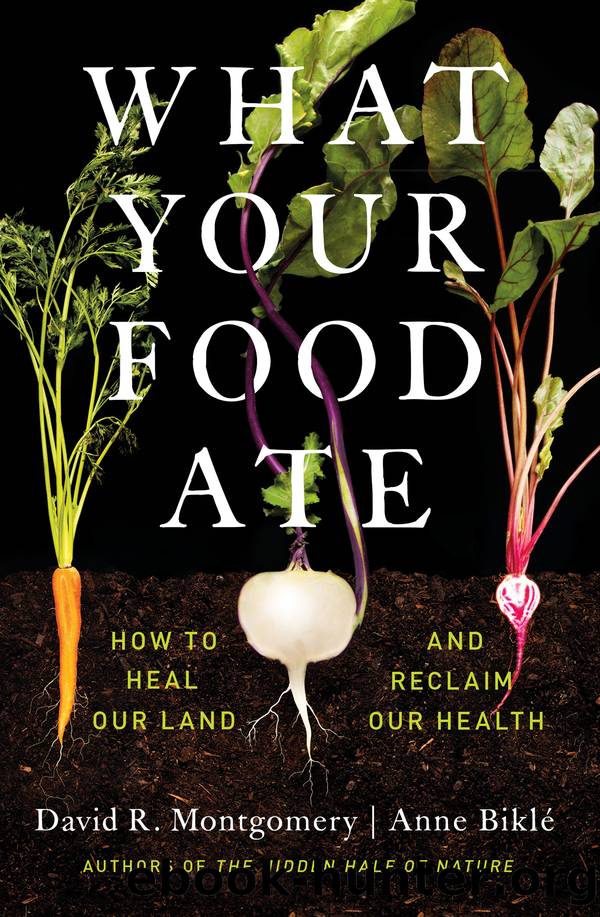What Your Food Ate by David R. Montgomery

Author:David R. Montgomery
Language: eng
Format: epub
Publisher: W. W. Norton & Company
Published: 2022-05-06T00:00:00+00:00
Men are not so much the keepers of herds as herds are the keepers of men.
âHENRY DAVID THOREAU
Looking for milk at the grocery store got a lot more complicated in recent years. When our parents were young, the choice lay between a few brandsâif, that is, one could find more than one option. Milk was just milk. It came from a local or regional dairy, and the cows mostly ate grass. When we were growing up in the 1970s, milk from cows still dominated the dairy cases of grocery stores, with options for different amounts of fat. Now, to find whole milk, cream, or half-and-half in the dairy section, you have to wade past all the other âmilksââsoy, coconut, hemp, almond, and so on.
Faux dairy products represent the most recent step in a century-long shift away from milk made in cows that ate living plants in a pasture. What did we lose in pivoting away from grass-fed milk? More than advertised, as industrialized animal husbandry optimized production for efficiencies dependent on cheap grain and energy. But it neednât be this way. Itâs possible to both increase the nutritional quality of milk and meat and reduce the environmental footprint of animal agriculture. Weâd just have to raise and feed animals really differently.
Ruminantsâcows, sheep, and goatsâare long-running mainstays of farming systems around the world. Their moniker comes from the rumen, an underappreciated part of their bodies crucial for their brand of herbivory. The rumen serves us well too, turning grass and leaves we canât digest into meat and milk we can.
The rumen is not a stomach. Those dissolve things. A rumen is an ecosystem that houses most of a ruminantâs microbiome. As in any other ecosystem, physical terrain creates different habitats that sustain various inhabitants. Stout ridges of cartilage lend strength and form to the rumen, creating distinct compartments that facilitate the fermenting action and movement of trillions of microbes navigating a sea of gastric juices, saliva, and partially chewed plants. Disturb it or feed it differently, and its tiny inhabitants change what they do and make inside their host. And as goes the rumen, so goes the ruminantâand the nutritional profile of her milk.
The size of a rumen generally scales with the size of the animal. Consider cows. A standard-size beer keg holds about 15 gallons. Add a second keg, and youâd be up to the size of the rumen in a small cow, about 30 gallons. Add a third keg, top it up with a few growlers, and you get to the large end of the rumen range, around 50 gallons.
After a century poking around in the rumens of a wide variety of domestic livestock breeds, scientists still donât fully understand this alive and dynamic place. Itâs a challenge to study because of the perpetually shifting relationships between microbiota and a ruminantâs diet. Nothing stays exactly the same from one day, or season, to the next. How ruminants acquire a good deal of their protein illustrates some of this dynamism.
Download
This site does not store any files on its server. We only index and link to content provided by other sites. Please contact the content providers to delete copyright contents if any and email us, we'll remove relevant links or contents immediately.
Craft Beer for the Homebrewer by Michael Agnew(18140)
Marijuana Grower's Handbook by Ed Rosenthal(3620)
Barkskins by Annie Proulx(3312)
Project Animal Farm: An Accidental Journey into the Secret World of Farming and the Truth About Our Food by Sonia Faruqi(3177)
The Plant Messiah by Carlos Magdalena(2883)
Red Famine: Stalin's War on Ukraine by Anne Applebaum(2873)
0041152001443424520 .pdf by Unknown(2784)
Organic Mushroom Farming and Mycoremediation by Tradd Cotter(2626)
In the Woods by Tana French(2533)
Beer is proof God loves us by Charles W. Bamforth(2370)
7-14 Days by Noah Waters(2361)
Reservoir 13 by Jon McGregor(2242)
Borders by unknow(2227)
Meathooked by Marta Zaraska(2220)
The Art of Making Gelato by Morgan Morano(2216)
Birds, Beasts and Relatives by Gerald Durrell(2175)
Between Two Fires by Christopher Buehlman(2164)
The 7 Habits of Highly Effective People: Powerful Lessons in Personal Change (25th Anniversary Edition) by Covey Stephen R(2139)
The Lean Farm Guide to Growing Vegetables: More In-Depth Lean Techniques for Efficient Organic Production by Ben Hartman(2096)
